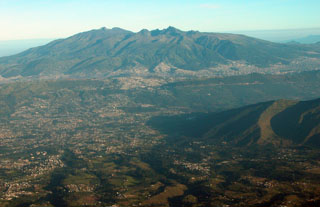Report on Guagua Pichincha (Ecuador) — October 1998
Bulletin of the Global Volcanism Network, vol. 23, no. 10 (October 1998)
Managing Editor: Richard Wunderman.
Guagua Pichincha (Ecuador) Crisis continues into November; many days with one phreatic explosion
Please cite this report as:
Global Volcanism Program, 1998. Report on Guagua Pichincha (Ecuador) (Wunderman, R., ed.). Bulletin of the Global Volcanism Network, 23:10. Smithsonian Institution. https://doi.org/10.5479/si.GVP.BGVN199810-352020
Guagua Pichincha
Ecuador
0.171°S, 78.598°W; summit elev. 4784 m
All times are local (unless otherwise noted)
The sequence of phreatic explosions initiated on 7 August (BGVN 23:09) continued from 28 October through 17 November (table 1). A substantial number of days were marked by one phreatic explosion. Visible explosions rose at most a few kilometers above the summit. Many explosions were accompanied by tremor; they were seismically characterized with reduced displacements.
Table 1. Some details of Guagua Pichincha's phreatic explosions, their size (as reduced displacements), and associated tremor, 27 October through 17 November 1998. A "--" signifies the data is either inapplicable or not reported. Extracted from the daily reports posted on the website of IG-EPN.
| Date | Phreatic explosions | Reduced displacement | Post-explosion tremor | Remarks |
| 27-29 Oct 1998 | 0 | -- | -- | -- |
| 30 Oct 1998 | 1 | 3.6 cm2 | 8 hours | -- |
| 31 Oct 1998 | 1 | -- | 30 minutes | -- |
| 31 Oct 1998 | 1 | -- | 20 minutes | -- |
| 01 Nov 1998 | 1 | 5.7 cm2 | -- | -- |
| 01 Nov 1998 | 1 | 10.7 cm2 | 3 hours | -- |
| 02 Nov 1998 | 1 | 12.2 cm2 | -- | -- |
| 03 Nov 1998 | 1 | 7.7 cm2 | -- | Plume rose to 3 km altitude. |
| 04 Nov 1998 | 1 | -- | -- | High amplitude, spasmodic tremor. |
| 04 Nov 1998 | 1 | 14.8 cm2 | 4 hours | -- |
| 05 Nov 1998 | 1 | 6.0 cm2 | 30 minuntes | -- |
| 06 Nov 1998 | 1 | 5.3 cm2 | -- | -- |
| 07 Nov 1998 | 4 | <~3.0 cm2 | -- | -- |
| 08 Nov 1998 | 0 | -- | -- | -- |
| 09 Nov 1998 | 0 | -- | -- | Fumarole "La Locomotora" gave off a 300-m-tall plume. |
| 11 Nov 1998 | 0 | -- | -- | Fumarole "La Locomotora" gave off a 600-m-tall plume. |
| 12 Nov 1998 | 1 | 4.4 cm2 | -- | -- |
| 13 Nov 1998 | 0 | -- | -- | Two-hour interval of tremor. |
| 14 Nov 1998 | 0 | -- | -- | Plume reaching 1 km tall. |
| 15 Nov 1998 | 1 | 5.7 cm2 | 20 minutes | Poor crater visibility; rockfalls and loud fumaroles heard by park rangers. |
| 16 Nov 1998 | 1 | 2.1 cm2 | -- | -- |
| 17 Nov 1998 | 1 | 1.7 cm2 | -- | Spasmodic tremor. |
As illustrated in the previous report (BGVN 23:09), volcano-tectonic, long-period, and multiphase earthquakes all escalated prominently during mid-September. During the current reporting interval, these remained elevated but did not increase, and the numbers of the various events, particularly volcano-tectonic and multiphase earthquakes, may have moderated or diminished slightly.
The number of explosions in a single day reached a new high for this crisis: four occurred on 7 November. The previous one-day record, three, had occurred only on two days in mid-October. Yet, the 7 November blasts were followed by four consecutive days with no explosions and, during 8-20 November no day had more than one explosion. As an indication of the pace of the venting, during 7 August-3 November the daily reports noted 59 explosions.
The highest plume seen during the reporting interval came from an explosion at 0715 on 3 November. It rose to ~3 km above the summit. Clear atmospheric conditions enabled residents to see it from the city of Quito. Although atmospheric conditions frequently blocked visibility, local observers saw fumarolic plumes rising from 100 to 1000 m. Thus, on 28 October a plume rose 100 m; on 9, 11, and 14 November, respectively, plumes rose 300, 600, and 1,000 m high. A plume on 4 November was of ambiguous origin, but it rose 1,000 m.
Geological Summary. Guagua Pichincha and the older Pleistocene Rucu Pichincha stratovolcanoes form a broad volcanic massif that rises immediately W of Ecuador's capital city, Quito. A lava dome grew at the head of a 6-km-wide scarp formed during a late-Pleistocene slope failure ~50,000 years ago. Subsequent late-Pleistocene and Holocene eruptions from the central vent consisted of explosive activity with pyroclastic flows accompanied by periodic growth and destruction of the lava dome. Many minor eruptions have been recorded since the mid-1500's; the largest took place in 1660, when ash fell over a 1,000 km radius and accumulated to 30 cm depth in Quito. Pyroclastic flows and surges also occurred, primarily to then W, and affected agricultural activity.
Information Contacts: Instituto Geofísico, Escuela Politécnica Nacional, Apartado 17-01-2759, Quito, Ecuador; El Comercio newspaper, Quito, Ecuador (URL: http://www.elcomercio.com); El Universo newspaper, Quito, Ecuador (URL: http://www.eluniverso.com); La Hora newspaper, Quito, Ecuador (URL: http://www.lahora.com); Volcanic Disaster Assistance Program, U.S. Geological Survey, 5400 MacArthur Blvd., Vancouver, Washington 98661 USA (URL: https://volcanoes.usgs.gov/observatories/cvo/); ORSTOM, A.P. 17-11-6596, Quito, Ecuador (URL: http://www.ird.fr/).

